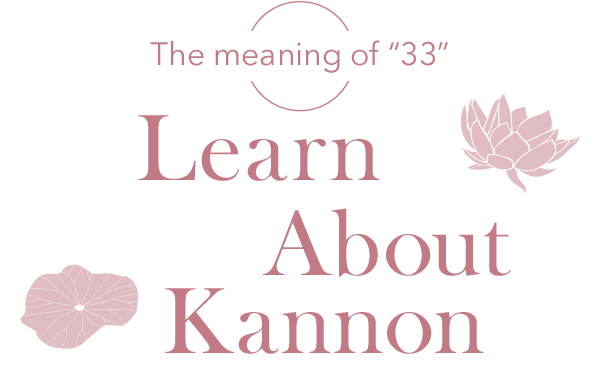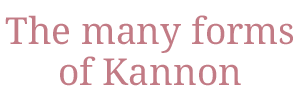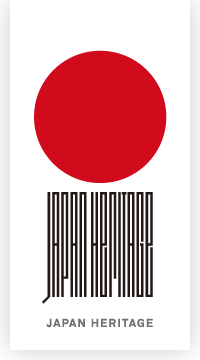


Kannon or Kannon Bosatsu is a bodhisattva appearing in the “Kannon-kyo” and “Hannya Shingyo” sutras. She is an individual who is training to achieve Buddhahood* and changes into many forms to provide salvation to the people of the world. It is thought that Kannon was originally portrayed as a man, but a large number of statues portray a beautiful woman, and she is especially worshiped this way throughout China and Japan.
![[聖観音]木造聖観音菩薩像(只見町)](https://aizu33.jp/en/wp-content/themes/aizu33/img/Kannon_title_p.png)
[Sho Kannon]Sho Kannon(Tadami Town)

Kannon has 33 forms suited to various situations. She can be anything from an old man or woman to a child, from a soldier to a priest, from a frightening demon to a heavenly maiden--whatever is needed to save people and answer their prayers. (These are known as the 33 Forms of Kannon) The number 33 (sanjusan) in the 33 Kannon and the Sanjusan gen-do Hall comes from this concept.

The following are explanations on how to identify some of the various Kannon statues often seen in the temples of the 33 Kannon in Aizu.
![[聖観音]鳥追観音(西会津町)](https://aizu33.jp/en/wp-content/themes/aizu33/img/Kannon_dummy_p1.png)
[Sho Kannon]Torioi Kannon(Nishiaizu Town)

1 Sho Kannon
The most basic form of Kannon, which appears as a normal human with one face and two arms. The bodhisattva takes this humanoid form to provide salvation to all living things.

This form usually has one face and two arms, with a lotus flow in her left hand. There is a miniature Amida Nyorai figure called a “Kebutsu” atop her head.

Torioi Kannon(The 3rd 'Bangai'of Aizu's 33 Kannon)、Tajima Tokusho-ji Temple(The 15th of Okurairi's 33 Kannon)、Kannon-ji Temple(The 1st of Inawashiro's 33 Kannon)
![[十一面観音]中田観音(会津美里町)](https://aizu33.jp/en/wp-content/themes/aizu33/img/Kannon_dummy_p2.png)
[Juichimen Kannon]Nakata Kannon(Aizumisato Town)

2 Juichimen Kannon
This Kannon has 10 or 11 faces in addition to her main one. According to the “Juichimen Kanjizai Bosatsu Shinmitsugon Nenju Kiki-kyo” sutra, she brings people 10 blessings in their current lives (Ten Victories) and 4 fortunes in the next life (Four Charities).
●Ten Victories
1. Protection from illness, 2. Acceptance by all Buddhas, 3. Never wanting for money or food, 4. Acknowledgment from royalty in the royal palace, 5. Protection from being harmed by one’s enemies, 6. Protection from dying in unforeseen incidents, 7. Protection from being harmed by any lethal weapons, 8. Protection from death by drowning or fire, 9. Warding off poison and deadly insects, 10. Protection from chills and fever
●Four Charities
1. The opportunity to meet Buddha on one’s death, 2. Protection from being reborn in hell, as a hungry ghost or as an animal, 3. Protection from an early death, 4. Being reborn in paradise

This form has 10 or 11 faces in addition to her main one.

Nakata Kannon(The 30th of Aizu's 33 Kannon)、Jigenzan Kannon-ji Temple(The 7th of Okurairi's 33 Kannon)、Saisho-ji Temple(The 3rd of Inawashiro's 33 Kannon)
![[千手観音]立木観音(会津坂下町)](https://aizu33.jp/en/wp-content/themes/aizu33/img/Kannon_dummy_p3.png)
[Senju Kannon]Tachiki Kannon(Aizubange Town)

3 Senju Kannon
Kannon with one thousand hand with one thousand eyes. She is typically shown with 11 faces and 42 arms. Her two main hands are joined together in front of her, and each of her additional 40 arms is meant to represent 25 worlds saved by Kannon (25 x 40 = 1,000). Each of her palms has an eye in it that represents Kannon’s vast mercy and power to save every life without overlooking a single creature.

She is typically shown as a figure with 11 faces and 42 arms, two of which are joined in front of her chest, two of which are holding begging bowls, and the remaining 38 of which are holding gems, lotus flowers, and other various tools used to save all living things.

Tachiki Kannon(The 31st of Aizu's 33 Kannon)、Furumachi Zendo-ji Temple Eiyo-do Hall(The 24th of Okurairi's 33 Kannon)、Nyue Bikuni-do Hall(The 16th of Inawashiro's 33 Kannon)
![[馬頭観音]厩嶽山馬頭観音菩薩坐像(磐梯町)](https://aizu33.jp/en/wp-content/themes/aizu33/img/Kannon_batohkannon_p.png)
[Bato Kannon]Umayasan Bato Kannon seated statue(Bandai Town)

4 Bato Kannon
Although Kannon is usually shown with a graceful feminine form, this Kannon has eyes that slant upward, hair pointing toward the sky, and a snarling fanged mouth, all combining to form a wrathful figure.

Bato Kannon is usually portrayed as a wrathful figure with the head of a horse on top of her head and making the Konponmakoin sign that represents a horse’s mouth in front of her chest.

Tsukahara Kannon(The 11th of Aizu's 33 Kannon)、Itozawa Ryufuku-ji Temple(The 21st of Okurairi's 33 Kannon)、Hosho-ji Temple(The 13th of Inawashiro's 33 Kannon)
![[如意輪観音]観音寺・木造如意輪観音坐像(喜多方市)](https://aizu33.jp/en/wp-content/themes/aizu33/img/Kannon_mokuzonyoirinkannon_p.png)
[Nyoirin Kannon]Kannon-ji Tenmple・wooden Nyoirin Kannon seated statue(Kitakata City)

5 Nyoirin Kannon
A Kannon with six arms who usually sits with one raised knee or in a half-lotus position and holds a sacred jewel and a dharma wheel in two of her hands.
The sacred jewel is said to fulfill all wishes and the dharma wheel is said to destroy worldly desires, so this Kannon is prayed to for aid escaping the evils of temptation.

This form is usually shown with six arms and sitting with a raised knee.

Takeya Kannon(The 8th of Aizu's 33 Kannon)、Tajima Yakushi-ji Temple(The 14th of Okurairi's 33 Kannon)、Sekiwaki Uba-do Hall(The 11th of Inawashiro's 33 Kannon)
![[准胝観音]准胝観音](https://aizu33.jp/en/wp-content/themes/aizu33/img/Kannon_Juntei_Kannon_p.png)
[Juntei Kannon]Juntei Kannon(※Reference image)
(出典:平安時代の仏像図集『図像抄』(十巻抄))

6 Juntei Kannon
This Kannon represents the truth of Buddhism, cleansing the movements of peoples’ hearts, leading them to enlightenment, and birthing innumerable Buddhas. She is also known as “Juntei Butsumo”or “Mother of Buddhas”, leading her to be prayed to for blessings of safe childbirth and conception. She is often shown with a three-eyed face and eight arms, and the large number of hands often causes her to be confused with Senju Kannon.

This form is usually shown with six arms and sitting with a raised knee.

Shimodate Kannon-do Hall(The 10th of Inawashiro's 33 Kannon)、Tonosu Matsuyo-do Hall(The 29th of Okurairi's 33 Kannon)
[Reference literature]
・『サライの仏像の見方』 『サライ』編集部編 株式会社小学館 2010年
・『【カラー版】日本仏像史』 水野敬三郎 監修 美術出版社 2001年













